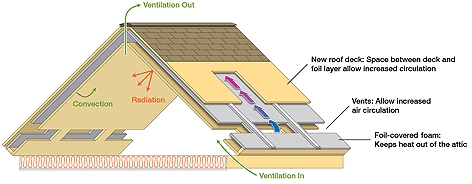The system is said to improve efficiency using controls for radiation, convection and insulation, including a passive ventilation system that pulls air from the underbelly of the attic into an inclined air space above the roof.
‘Heat that would have gone into the house is carried up and out,’ said Bill Miller of ORNL’s Building Envelope Group. ‘And with a passive ventilation scheme, there are no moving parts, so it’s guaranteed to work.’
According to a statement, the new roof system design can be retrofitted with almost all roofing products. The heart of the design is a foiled covered polystyrene insulation that fits over and between rafters in new construction or can be attached on top of an existing shingle roof system.
Poorly sealed HVAC ducts leak conditioned air into an attic, which typically costs homeowners $100 (£62) to $300 per year based on ORNL computer simulations.
To address the problem, homeowners pay up to $8,000 to seal the attic with spray foam, which can save upwards of $460 a year. For less initial cost and the same number of payback years, homeowners can retrofit the attic with the new design for about $2,000 and save $100 a year.
Looking to the future, Miller and colleagues are working on designs with lower initial installation costs, and greater cost-effectiveness overall.
A paper, Prototype Roof Deck Designed to Self-Regulate Deck Temperature and Reduce Heat Transfer, was published by the National Roofing Contractors Association.
Authors include W Miller, Stan Atherton and Russell Graves of the University of Tennessee, Knoxville, and Billy Ellis of Billy Ellis Roofing.






Red Bull makes hydrogen fuel cell play with AVL
Formula 1 is an anachronistic anomaly where its only cutting edge is in engine development. The rules prohibit any real innovation and there would be...